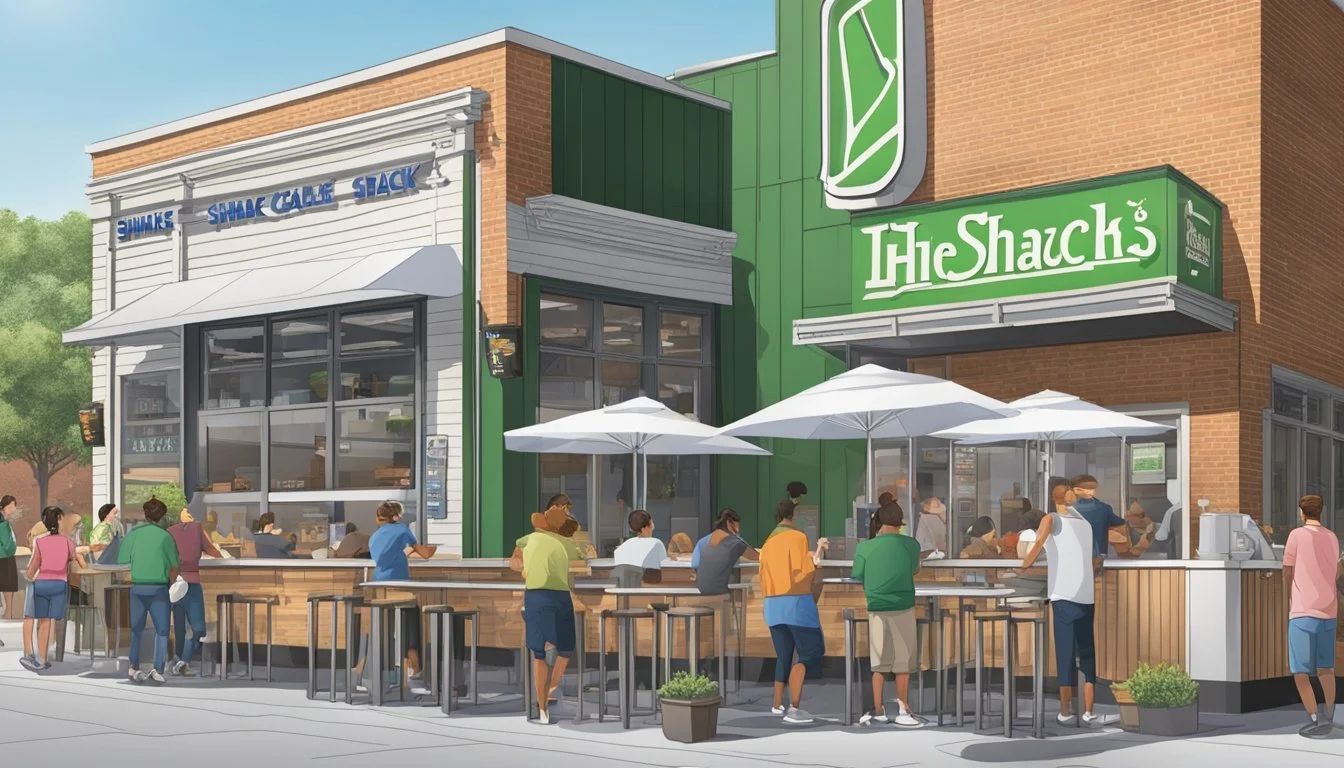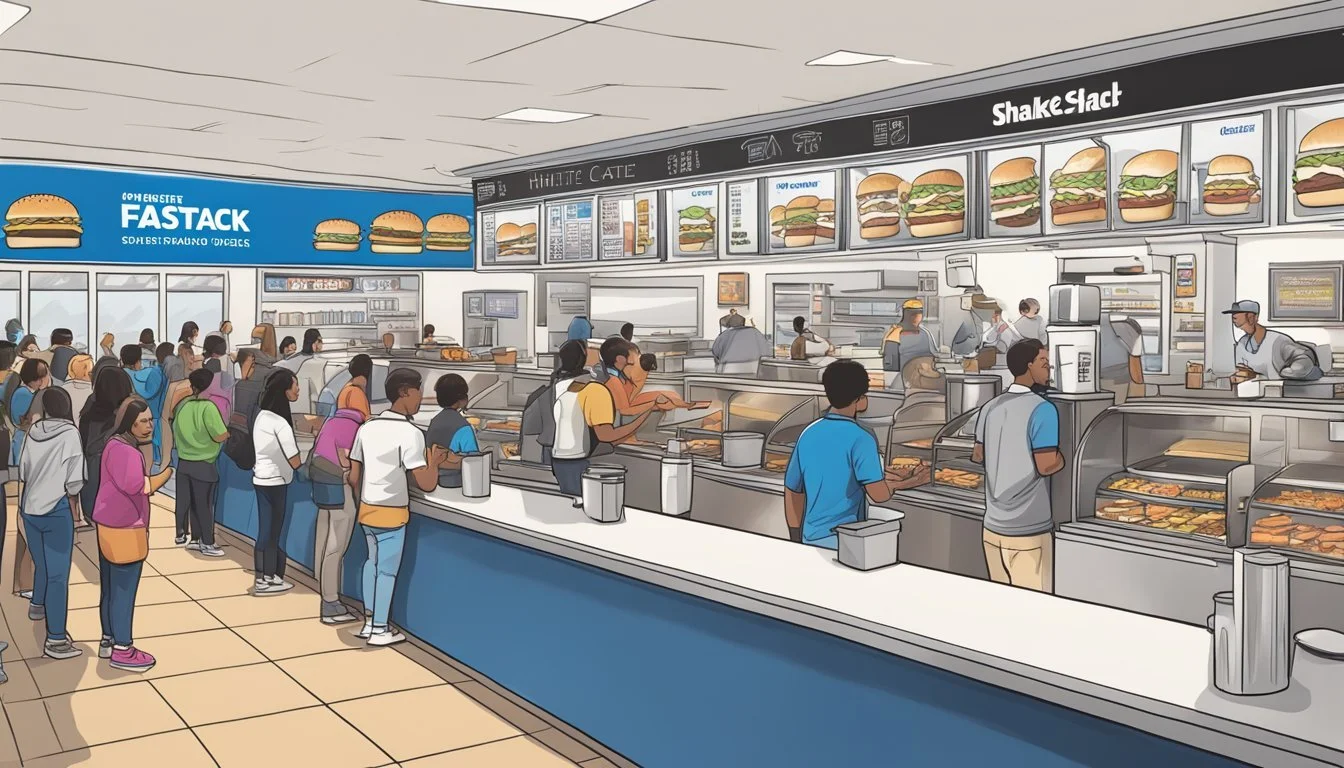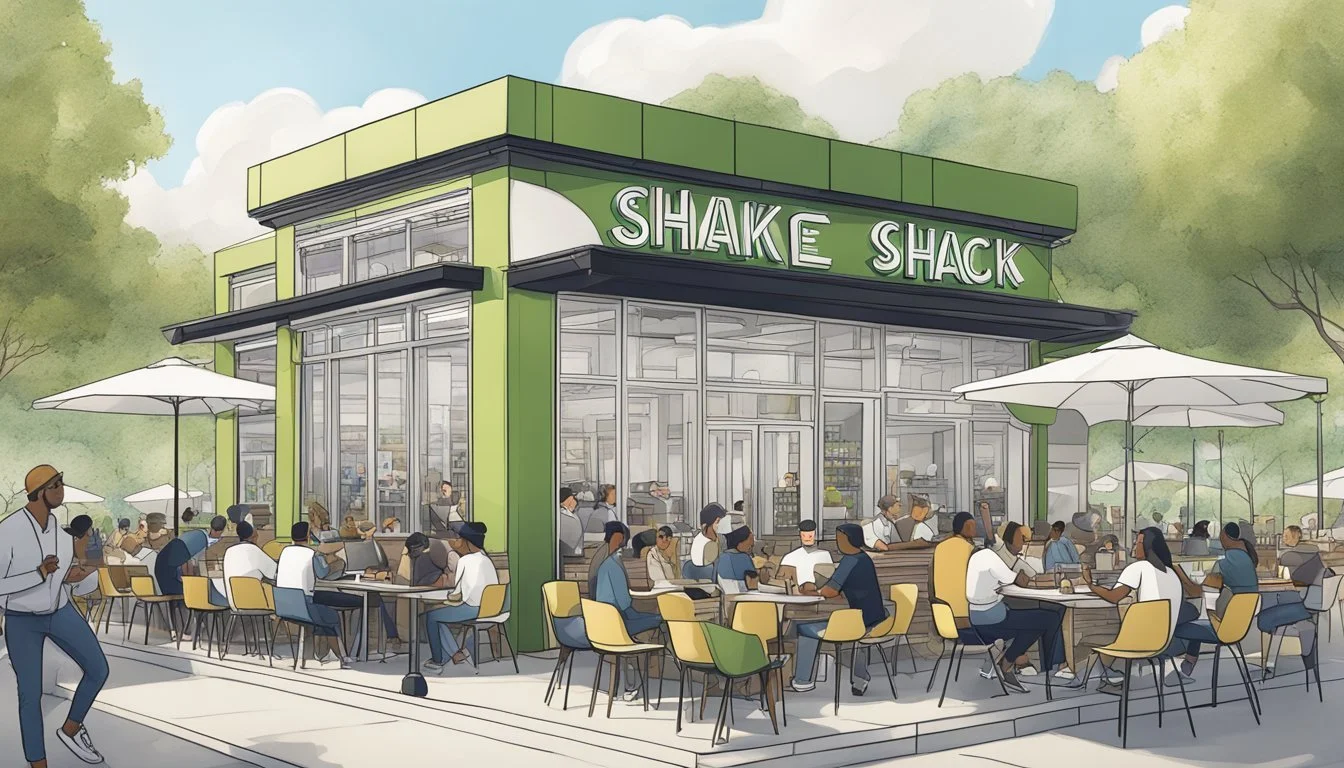Shake Shack vs White Castle
An Unbiased Comparison of Iconic Burger Eateries
The landscape of American fast food is diverse, with burger joints standing as time-honored pillars in the industry. Shake Shack and White Castle have carved out their unique spaces in this savory realm, each offering a distinct take on the classic American burger. Shake Shack, known for its 100% Angus beef patties and modern takes on fast-food fare, presents a gourmet approach to the traditional burger experience. Contrastingly, White Castle holds a longstanding history as a pioneer of slider-style burgers, offering small, square hamburgers that have been a cultural staple since 1921.
The debate over which burger chain reigns supreme is a common topic among fast food aficionados. Shake Shack boasts a menu with a variety of innovative burgers, such as the Avocado Bacon Burger and the Spicy ShackMeister, made with fresh, never frozen, hormone- and antibiotic-free Angus beef. On the other hand, White Castle's appeal lies in its heritage and consistency, serving up sliders that have barely changed in taste and presentation for nearly a century. While Shake Shack caters to a desire for upscale, quality ingredients and original recipes, White Castle appeals to nostalgia and simplicity with its straightforward, no-frills sliders.
Choosing between Shake Shack and White Castle often comes down to individual preferences in taste, dining experience, and value—each brand represents different aspects of America's burger culture. Shake Shack's focus on quality and innovation matches the tastes of those seeking a more refined fast-food option, while White Castle's commitment to tradition satisfies those craving a quick, familiar, and cost-effective meal. As the debate continues, burger enthusiasts weigh in, comparing everything from the juiciness of the patties to the atmosphere of the establishments.
Historical Overview
Shake Shack began as a humble hot dog cart in Madison Square Park, New York City, in 2001. Inspired by his love for classic Chicago hot dog stands, Danny Meyer, the man behind the brand, launched the cart to support the Madison Square Park Conservancy's first art installation. The cart was an instant success and over three summers morphed into a permanent kiosk in 2004. This marked the birth of Shake Shack as a modern "roadside" burger stand known for its delicious burgers, hot dogs, frozen custard, shakes, beer, wine, and more. The company has since expanded internationally, maintaining a commitment to premium ingredients and fostering a strong community connection.
White Castle, on the other hand, holds the title of being the first fast-food hamburger chain in the United States. Founded in 1921 by Billy Ingram and Walter Anderson in Wichita, Kansas, White Castle introduced the concept of a limited menu with fast service and high-volume output. They are famous for their small, square hamburgers, known affectionately as "sliders," and they played a pioneering role in the development of the fast-food industry. With its distinctive white-painted buildings and interiors reminiscent of a castle, it cultivated an image of cleanliness and order.
Shake Shack
Founded: 2001
Expansion: Expanded internationally
Known For: Premium ingredients
White Castle
Founded: 1921
Pioneered: Fast-food hamburger chain
Known For: "Sliders" and high-volume output
Both brands have a rich heritage within the fast food landscape, and each respectively transformed the American casual dining experience in its own way. While Shake Shack represents the rise of "fast-casual" dining with an emphasis on quality, White Castle's innovations set the stage for the fast-food industry's future.
Burger Quality and Variety
In comparing Shake Shack with White Castle, one must inspect their offerings in terms of the ingredients' quality and the range of options available. Each restaurant approaches burger creation with distinctive methodologies and ingredient selections, which are explored in the subsections below.
Meat and Patty Flavors
Shake Shack prides itself on using 100% Angus beef for its patties, which are never frozen and are free from hormones and antibiotics. The chain's commitment to quality beef results in a flavorful, juicy patty with a slight caramelization from the smashing technique used during cooking. This contrasts with White Castle, known for its iconic sliders which feature a steam-grilled beef patty atop a bed of onions. While thinner than Shake Shack's, the patties have a unique flavor profile due to their preparation method.
Bun Varieties
Shake Shack serves its burgers on non-GMO Martin's Potato Rolls, which are soft and slightly sweet, complementing the savory flavor of the meat and cheese. On the other hand, White Castle's sliders are placed on small, squishy buns that absorb the onion's steam and beef juices, integral to the slider experience.
Cheese and Toppings
Both establishments offer a variety of cheese options and toppings. Shake Shack provides a selection of premium toppings, including crisp lettuce, fresh tomatoes, and a proprietary ShackSauce. White Castle keeps it simple with options like American cheese, pickles, and onions, staying true to the classic slider model. However, Shake Shack tends to offer more gourmet-influenced topping combinations.
Signature Burgers
Shake Shack's signature offering, the ShackBurger, consists of a cheeseburger topped with lettuce, tomato, and ShackSauce. It epitomizes the chain's approach to a simple yet high-quality burger. White Castle's claim to fame, meanwhile, is its original slider—a small, square beef patty with onions and pickles on a soft bun, offering a bite-sized yet satisfying flavor experience.
Customer Experience and Branding
When comparing Shake Shack and White Castle, customer experience and branding play pivotal roles in differentiating these two fast-food contenders.
Ambiance and Store Layout
Shake Shack has cultivated an image that resonates with a modern audience, emphasizing a comfortable and trendy environment that stands apart from typical fast-food restaurants. The layout of their stores often features clean lines, an open kitchen design, and community seating that encourages a social dining experience.
White Castle, a regional chain known for its iconic sliders, offers a more traditional fast-food experience. Their stores are designed for efficiency, often smaller in size with a focus on the drive-thru service which makes it convenient for customers looking for a quick meal.
Brand Image and Marketing
Shake Shack markets itself as a national chain that offers a premium burger experience, utilizing fresh, high-quality ingredients and an iconic brand aesthetic. Their marketing efforts include engaging with customers on social media and promoting their commitment to sustainability and community involvement.
On the flip side, White Castle enjoys a nostalgic brand image, seen as the original fast-food burger joint. They leverage their long history and cultural impact through marketing campaigns that highlight their status as a beloved, regional chain with a dedicated fan base.
Menu Diversity and Speciality Items
Shake Shack and White Castle both offer distinct menu options that cater to a range of tastes, including classic burger joint selections and specialty items unique to each brand.
Vegetarian Options
Shake Shack has gained attention for its 'Shroom Burger, a crispy fried portobello mushroom filled with melted cheese, lettuce, tomato, and ShackSauce. They also provide a Veggie Shack that includes a custom veggie patty comprised of greens, grains, and herbs, and can be ordered vegan by forgoing the cheese.
White Castle, in contrast, offers a variety of sliders, including the Impossible Slider, which features the plant-based Impossible burger patty adorned with smoked cheddar cheese, pickles, and onions, although the cheese can be omitted for a vegan option.
Accompaniments
Both establishments take pride in their sides, particularly their fries. Shake Shack’s fries are crinkle-cut and can be enjoyed plain or with cheese. Condiments like ketchup and mustard are standard, and guests can elevate their fry experience with add-ons like ShackSauce or cheese sauce.
White Castle's sides include fries, also served with a choice of condiments such as ketchup and their signature Zesty Zing sauce. In keeping with their slider theme, they also serve Chicken Rings, appealing to those who want an alternative to the traditional side of fries.
Beverages
When it comes to beverages, Shake Shack is known for its wide range of milkshakes, offering flavors like vanilla, chocolate, strawberry, and special editions like the coffee shake or the seasonal Black & White shake. They also serve beer and wine for those looking for something stronger.
Conversely, White Castle primarily focuses on soft drinks to accompany their meals, although select locations may offer beer as well. Their shakes are more traditional, with the primary flavors of vanilla and chocolate always available.
Pricing and Value for Money
When it comes to pricing, Shake Shack is perceived as slightly more upscale in the fast-food industry. Their double cheeseburgers may cost around $7.40, reflecting their commitment to quality ingredients and customer experience. While not the cheapest option, many customers find the taste and quality offer good value for the money, especially for what some consider one of the best fast-food burgers on the market.
Shake Shack
Item: Double Cheeseburger
Price: ~$7.40
White Castle
Item: Slider
Price: ~$2.00 per slider
In contrast, White Castle champions affordability with its iconic sliders. A double cheeseburger equivalent—usually two sliders—can cost around $2.00 or less, making White Castle a go-to for budget-conscious consumers seeking quick and satisfying meals. Although less expensive, White Castle does not typically compete in the gourmet burger space, instead focusing on delivering a consistent, wallet-friendly product to its clientele.
Customers choose between these two establishments based on their individual valuation of cost versus quality. Shake Shack positions itself as offering a premium burger experience at a higher price point, while White Castle offers an economical, straightforward fast-food experience. Each brand thus caters to different segments within the burger-eating market, both having carved out their distinct niches based on what they offer for the money spent.
Nutritional Information
When comparing Shake Shack and White Castle, nutrition plays a key role in assessing which burger joint might be the better option for health-conscious individuals. Here is a succinct overview of the nutritional content for signature offerings from each establishment.
Shake Shack is known for its 100% all-natural Angus beef burgers. A single ShackBurger® contains approximately:
Calories: 500
Total Fat: 30g
Saturated Fat: 12g
Shake Shack prides itself on using no hormones and antibiotics in its beef. However, their offerings can be relatively high in calories and fats, which is something diners should keep in mind.
White Castle, on the other hand, offers smaller-sized sliders that normally contain less calories and fat per serving when compared to typical fast-food burgers. For example, one White Castle slider contains roughly:
Calories: 140
Total Fat: 6g
Saturated Fat: 2.5g
It's important to note that while each individual slider may seem like a lighter option, they are usually consumed in larger quantities, which can quickly add up in terms of caloric and fat intake.
Both burger joints provide nutritional information on their websites and have options on the menu that are on the lower end of calories and fat if that is a priority for the diner. When making decisions based on nutrition, it is crucial to consider both the per-serving content and the overall consumption during a meal.
Cultural and Regional Influence
Shake Shack and White Castle each hold iconic status in their respective origins, with Shake Shack rising from New York's modern culinary scene and White Castle rooted in early 20th-century Midwest beginnings. Their influence extends from these regions, shaping the identity and preferences of local and international consumers.
East Coast vs West Coast Presence
Shake Shack originated in New York City and has become synonymous with the East Coast, particularly for offering a modern, upscale twist to fast food. Its expansion strategies have focused on large urban centers and culturally significant spots, reaffirming its association with the vibrant, fast-paced East Coast lifestyle.
On the opposite side, White Castle is often credited with being the first fast-food hamburger chain in the United States, establishing its first location in Wichita, Kansas, and eventually becoming a staple in the Midwest. While not traditionally linked to either coast, its cultural footprint is undeniable, having largely influenced the fast-food industry nationwide.
In-N-Out, while not the focus of this comparison, is an important mention as a cult favorite that greatly represents the West Coast, specifically California, where it was founded. It adds another layer to the regional burger identity of the U.S. by providing a contrast to the offerings and expansion strategies of Shake Shack and White Castle.
International Appeal
Shake Shack has made significant inroads internationally, capitalizing on its New York branding to appeal to a global audience. With locations in countries such as Japan, South Korea, and the United Kingdom, Shake Shack's international reach speaks to a cosmopolitan image that resonates with a diverse customer base looking for an American dining experience abroad.
In contrast, White Castle has remained largely a domestic endeavor, with its international presence being minimal. This could be attributed to the brand's strong association with the American heartland and a style of fast food that may not translate as readily to the international market in comparison to Shake Shack's more gourmet approach.
Customer Loyalty and Community Engagement
Shake Shack and White Castle both command a unique position in the hearts of burger lovers due to their distinct approaches to customer loyalty and community engagement.
Shake Shack has cultivated a loyal following by offering a premium fast-casual dining experience, emphasizing quality ingredients and customer satisfaction. The likelihood to Recommend (LTR) metric and Net Promoter Score (NPS) are pivotal in measuring and activating customer insights for the brand. Through a focus on community engagement, Shake Shack continues to establish a personal connection with their customers, contributing to a strong sense of loyalty.
Community Events: Participates in local events and collaborates with neighborhood businesses.
Feedback Mechanisms: Encourages customer feedback through multiple channels.
White Castle, known for its iconic slider, attracts a different demographic of burger enthusiasts. It has built a reputation on tradition, affordability, and a unique dining experience. While community engagement may be less pronounced in comparison to Shake Shack, White Castle maintains customer loyalty through:
Cult Following: The "Craver" fan base, forged by decades of consistent quality and service.
Secret Menu: Off-the-menu items that generate buzz and enhance the customer experience.
Engagement Factor Comparison
Shake Shack
Secret Menu: Not a focal point
Community Focus: High emphasis
Loyalty Measures: LTR (Lifetime Revenue) and NPS (Net Promoter Score)
White Castle
Secret Menu: Integral part
Community Focus: Moderate
Loyalty Measures: Tradition-based
These dining establishments tailor their strategies to reflect the values and preferences of their respective audiences, all while ensuring their community and loyal burger lovers receive an experience that's both personal and reflective of their brand identities.
Comparison to Other Fast-Food Chains
In assessing Shake Shack versus White Castle, it's key to recognize their distinctive offerings in relation to fries and nuggets, diversification of burger styles, and price points when compared to other popular fast-food chains.
Fries and Nuggets Matchup
When Five Guys enters the fray with its hand-cut fries, seasoned with hearty skins on, Shake Shack and White Castle face stiff competition, albeit with their own unique fry offerings. Shake Shack’s crinkle-cut fries have a dedicated following, while White Castle's seasoned fries hold their own. On the nuggets front, chains like Wendy's and McDonald's remain classic go-tos with their crispy and tender options, offering a contrast to Shake Shack’s Chick’n Bites and the lack of a nugget option at White Castle.
Diversity in Burger Styles
Shake Shack shines with its modern twist on the classic burger, featuring high-quality Angus beef, while White Castle keeps to its traditional slider approach that has withstood the test of time. Yet there's a wide array of styles to consider; In-N-Out Burger is famed for its fresh, simple, and customizable “not-so-secret” menu. On the other hand, Whataburger's expansive menu includes distinctive offerings like the Honey BBQ Chicken Strip sandwich, contrasting with Shake Shack's focused menu and White Castle's slider-centric approach. Chains like Culver's are known for adding variety with their ButterBurgers and Dairy Queen, known more for ice cream, features burgers that are often overlooked.
Price Point Battles
Shake Shack is often seen as a premium option with prices to match, which might deter the budget-conscious diner who might favor Checkers or Burger King for their lower-priced, value-focused menus. White Castle, with its more economical sliders, provides a budget-friendly option. Meanwhile, Sonic and Jack in the Box offer mid-range pricing, balancing cost with a diverse menu selection. Patrons seeking a more upscale fast-food experience may gravitate towards BurgerFi or Fuddruckers, known for their higher-end gourmet burgers.
Innovation and Trends in Fast Food
In the competitive landscape of fast food, Shake Shack and White Castle both strive to stay ahead through innovative practices and embracing current trends that meet consumer demands.
Health-Oriented Movements
Shake Shack has differentiated itself by prioritizing health in their menu options. They've received commendation for serving antibiotic-free beef, aligning with a growing consumer preference for wholesome, responsible meat sourcing. This includes their use of 100% Angus beef, which is typically considered a higher-quality option due to its marbling and flavor.
White Castle, while known for its iconic mini hamburgers or 'sliders', has also made moves to accommodate health trends. They introduced a plant-based slider, catering to those looking for alternatives to the traditional beef patty.
Limited Edition Items
Both chains have experimented with limited edition items to create buzz and draw in customers looking for novel experiences.
Shake Shack often features unique menu items like special edition burgers or seasonal crinkle-cut fries. These limited-time offerings keep their menu fresh and intriguing for regulars and newcomers alike.
White Castle has successfully utilized limited-time offerings as a strategy to maintain customer interest. They often extend their menu beyond the expected range for a fast-food chain, such as integrating seafood options during certain times of the year.
By embracing these innovations and trends, Shake Shack and White Castle continue to compete in the dynamic fast-food industry without compromising their unique identities.
Environmental and Ethical Consideration
When comparing Shake Shack and White Castle, both take distinct approaches to environmental and ethical responsibilities in their operations. Shake Shack has received commendations for its use of antibiotic-free beef, a significant step in addressing public health concerns related to the overuse of antibiotics in livestock. The chain has made efforts to provide a variety of menu items that cater to different dietary preferences and is mindful of its environmental impact.
Shake Shack's commitment to sustainable practices extends to its building design, which often incorporates eco-friendly materials. Moreover, they offer alternative proteins to customers, reflecting an awareness of the environmental impact of beef production.
In contrast, White Castle has also engaged in environmentally friendly practices. They were one of the first fast-food chains to offer plant-based burger options, partnering with Impossible Foods to reduce reliance on traditional meat products. This initiative represents a shift towards a more ethical and environmentally conscious menu.
Both brands aim to reduce their carbon footprint, though Shake Shack frequently highlights its commitment to sustainably sourced ingredients and environmentally responsible packaging.
The companies demonstrate awareness of the industry's impact on the environment and attempt to mitigate this through their respective policies and practices.
Conclusion
When comparing Shake Shack and White Castle, the choice hinges on personal preferences and priorities. Shake Shack stands out with its grass-fed, hormone-free beef and a reputation for quality ingredients. Their iconic Shackburger has been well-received, particularly for those seeking a more gourmet fast-food experience.
White Castle, on the other hand, caters to a different market with its iconic sliders that have been a staple since 1921. These sliders, known for their steamed onions and pickle slices, offer a unique taste that many find nostalgic and satisfying, especially for those who prioritize efficiency and tradition.
Nutrition and Pricing
Shake Shack: Higher pricing, more calorie-dense options, quality-focused.
White Castle: More budget-friendly, lower-calorie choices, convenience-oriented.
In terms of ambiance, Shake Shack often features a modern and community-focused environment, while White Castle maintains a classic American eatery vibe.
Ultimately, whether one chooses Shake Shack for its premium offerings or White Castle for its distinctive sliders and historical significance, each burger joint serves its audience with a clear and distinct vision of what a fast-food experience can be.













